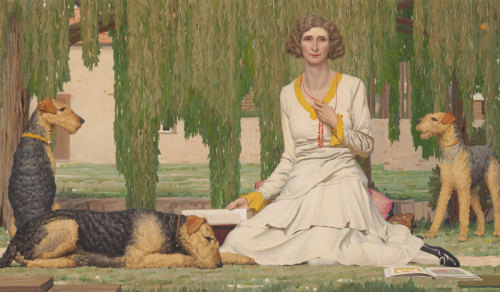War is ugly and brutal. It is messy and destructive. But it also inspires creativity - from scientific, technological and medical inventions and developments to great art and culture. War artists are fascinating as they capture and portray moments in the heat of battle that inform and inspire those who weren't there. Of course this can be propaganda; slanted in whichever direction is required to get the desired message across. They highlight situations and individuals and hold them in an artistic embrace; imbuing commonplace events with eloquent significance.
Some time ago I went to the Australian War Memorial and enjoyed some of this sensational art. Here are some of my favourites in very different styles.
 |
| Moresby Picture Show (1943) by Charles Bush |
Light entertainment provided a necessary distraction from the hard jungle fighting and difficult living conditions in New Guinea. In this work, a vibrant Disney cartoon is oddly set in a war zone and contrasted against the drab green of the mountainous tropical landscape. The searchlight in the distance is a subtle reminder of the war.
The weight and weariness of the soldiers in the foreground are contrasted with the lightness of subject and the luminosity of the Disney character projected on the screen. The figures stand stoically still in the drizzling rain and uncomfortable conditions, enjoying the simple pleasures of the light entertainment. Each silhouette is unique, and the distinctive Australian slouch hat can be seen on the figure on the far left of the picture.
The tropical climate of New Guinea presented soldiers with harsh conditions for both combat and general living. Most were not accustomed to the high humidity, let alone the inhospitable jungle and terrain. Those stationed at Port Moresby would have greeted the screening of films with much anticipation, welcoming any distraction from the realities of day-to day living in New Guinea. Such events also provided the artist with atypical subject matter and an opportunity to record less grim aspects of wartime activity.
 |
| Hospital Ward, Burma-Thailand Railway (1946) by Murray Griffin |
This work pictures Australian prisoners of war who were forced by the Japanese to build the Burma-Thailand railway. The artist depicted the atrocious conditions in the labour camps based on eyewitness reports by survivors. Griffin's use of light and shade in this work accentuates the physical condition and obvious suffering of the men as they struggle to survive malnutrition and disease, as well as drawing comparisons to the depths of hell. The skeletal men are barely distinguishable from the makeshift bamboo shelter.
Griffin was serving as an official war artist in Singapore when it was captured, and became a prisoner of war in Changi. He originally volunteered to go to the railway, thinking conditions might be better, but gave up his spot for another man and remained in Changi for his entire captivity. Griffin was appalled by the condition the men returned in from the railway, and sought to make records of events and conditions that occurred on the railway from survivor testimony.
 |
| Bomber Crew (1944) by Stella Bowen |
On 27 April 1944 at RAF Station Binbrook in Lincolnshire, Stella Bowen drew studies for a planned group portrait of a Lancaster Bomber crew, comprising six Australians and one Englishman, of no. 460 Squadron. This was the most highly-decorates Australian squadron in Bomber Command, but had suffered the highest casualties. Bowen was commissioned to paint a typical crew that flew Lancaster bombers on the intense bombing raids over Germany and occupied Europe. Preoccupied with their flight preparations, the men expressed no particular interest in Bowen's attempt to draw them, but their bravery, youth and vulnerability captivated the artist.
The next day the crew was reported missing, presumed dead: only Pilot Officer Thomas Lynch survived. Bowen completed the group portrait from sketches and official photographs. She wrote, "It was horrible having to paint the picture after the men were lost: like painting ghosts."The crew is depicted in front of the menacing image of their Avro Lancaster bomber, looming above them like a bird. They are shown wearing their full flying gear including 'Mae West' life jackets, flying helmets and headphones. Their names appear on the helmets and are repeated on the wreath-like ribbon that scrolls across the canvas, complete with their RAAF wings floating like cherubs.
 |
| Flak Busters (1945) by Dennis Adams |
Australian Beaufighters of No. 455 Squadron, based in Norfolk, England, attack a German minesweeper off the coast of Norway. They co-operated on many shipping strikes with a New Zealand Beaufighter Torpeo Squadron (489 Squadron RNZAF). In those attacks the Australian aircraft came in and fired both rocket projectiles and 20mm cannons. The ship 'saturated' by this fire would then be attacked by the torpedo Beaufighters.
During the Second World War, Australian artists frequently drew on various modern art movements to form chaotic and jarring compositions that interpreted weapons and machines, military life, and the visual experience of battle. One such influence was the literary and artistic movement known as futurism. It developed in Italy, where it was active in various incarnations from 1909 to the 1930s.
At its core futurism celebrated the machine age. Its adherents wanted to renew cultural and artistic ideas to reflect the strengths and dynamic nature of machines and life in modern cities. In general, futurist works of art emphasised movement and dynamic tension between typically geometric pictorial elements. In this image the artist paints the ship overwhelmed by a barrage of repeated explosions and jutting shafts of water and light.








